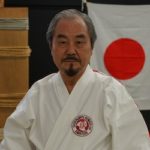The Original Okinawa Style of Shorinjiryu Kenkokan Karatedo Kata Training Method (11-07-2017)
 This method is derived from the principle of the four seasons, combined with proper breathing. Kata training will improve the mind, technique and body, teaching self-defense while giving one a healthy body and mind.
This method is derived from the principle of the four seasons, combined with proper breathing. Kata training will improve the mind, technique and body, teaching self-defense while giving one a healthy body and mind.
True Kata training helps one master offense and defense techniques as a fighting method and build up the mind, spirit and power to have a healthy and strong body. The ultimate goal of Kata is to master the principles of fighting and true Super Karate Koshiki Contact Karatedo techniques. An additional benefit of Kata is that the training is suitable for people of all ages and physical conditions to perform.
- In the static training method, the basic Kata is “Kudaka no Sanchin”. The basic open hand Kata (also meaning advanced Kata) is “Kudaka no Seisan”.
- In the active training method, the basic Kata is “Koshiki Naihanchin”. The basic open hand (advanced) Kata is “Koshiki Bassai”.
In interpreting and applying Kata, there are three key dimensions: the surface interpretation, back side (reverse) interpretation, and hidden interpretation. The surface interpretation can be translated to the obvious technique of punching, kicking or striking, called Go-ho (hard way). The back side (reverse) technique is generally the throwing, locking and choking technique which is called Ju-ho (soft way). The hidden technique usually refers to weapons techniques (called Buki-ho) which include the six foot Bo stick, trident knife (SAI), or Ken (Sword).
The Study of KATA
Karatedo originated in Okinawa. In Okinawa, practicing Kata had a special meaning because Karate teachers taught Kata only to trusted students in secret. In this context, it is possible to say Kata is really the bible and Cultural Heritage of Traditional Okinawa Karate-do.
To learn Super karate Kata correctly is to learn the interpretation of Kata at the surface, reverse and hidden layers; which means to understand the three ways of Go-ho (hard way), Ju-ho (soft way) and Buki-ho (weapons).
At first, one should study the soft interpretation and exercise various applications of Kata throwing, locking and choking techniques with a partner in paired work. Next, one should practice the hard way, which is the application of punching, kicking and striking techniques. In the advanced level you should learn and practice weapons applications with the Bo (six foot staff) and Ken (sword). Then you will have a complete understanding of Ksts.
You should always continue training and studying traditional Kata because there are an unlimited number of applications depending on the situation. You need to keep on improving to perform proper Kata mentally and physically.
In original Okinawa karate teaching, it was said that “Karate starts from Kata and finishes with Kata.” There are various interpretations of this. But an obvious one is to study Kata to learn the correct motions as a beginner, and once you get your black belt, you should study the application of KATA which provides deep knowledge for real combat. Through continued Kata training you can use the techniques, strategy and mindset in an emergency situation.
According to the stories about an old karate grandmaster Choki MOTOBU, he was famous as a top fighter, but his training consisted almost entirely of practicing the basic Kata Naihanchin for three years initially, then practicing Kata Bassai and studying the deep level of applications for Kumite (Sparring) and real combat embedded in these Kata. In the early Showa era in Okinawa everyone knew of the great MOTOBU, and it was said that “No enemy stands in front of MOTOBU….”.
Hanshi, Shinan